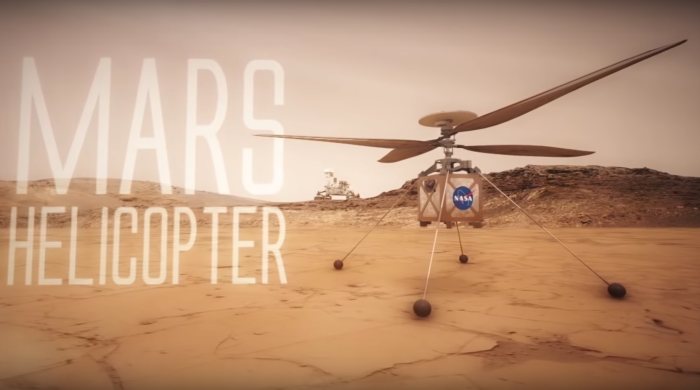
Image: NASA
Boffins at NASA have been successful in their efforts to develop a solar powered helicopter drone that will be part of the Mars 2020 rover mission.
This development is no mean feat. Mars holds some special challenges for the use of airborne drones, including an atmosphere that is a hundred times thinner than Earth’s that requires such craft to be very light and powerful.
What NASA has come up with is a helicopter drone weighing around 1.8 kilograms featuring twin, counter-rotating blades that will spin at around 3,000 rpm – about 10 times the rate of a helicopter on Earth (but blades on small drones used here on Earth spin much faster).
The energy required for operation will be supplied from solar cells charging a lithium-ion battery pack.
The Mars helicopter will be stowed in the belly pan of the Mars 2020 rover. When a suitable site is located to deploy the device, it will be placed on the ground and the rover will move a safe distance away. The solar cells will then go to work in charging the battery, tests performed and then hopefully it will be launched for its historic flight.
On its first flight, the “marscopter” will climb to around 3 metres and hover for approximately 30 seconds. In subsequent test flights (5 planned in total), distances will be increased up to a few hundred meters and durations of up to 90 seconds.
Due to communications delays, the marscopter will receive instructions prior to the short missions and then perform the flights autonomously.
“The ability to see clearly what lies beyond the next hill is crucial for future explorers,” said Thomas Zurbuchen, Associate Administrator for NASA’s Science Mission Directorate. “We already have great views of Mars from the surface as well as from orbit. With the added dimension of a bird’s-eye view from a ‘marscopter,’ we can only imagine what future missions will achieve.”
Regarding the Mars 2020 rover, unlike the solar panels used to power predecessors Spirit and Opportunity, it has a radioisotope power system. So does Curiosity, which has been operating on Mars since 2012.
The new mission is currently scheduled to launch in July 2020.
Opportunity Soldiers On
In related news, solar powered Rover Opportunity is continuing to explore the red planet and defy expectations.
We reported in February that Opportunity was about to see its 5,000th Martian dawn. Originally intended to only last for three months, Opportunity has racked up 14 years of active duty so far. According to the latest update (May 8), Opportunity’s solar array energy production was 667 watt-hours for that day. That’s pretty impressive considering its solar panels were expected to generate approximately 140 watts of power for up to four hours per day (560 watt-hours) when they were new and assuming optimal conditions.
As at May 8, Opportunity had clocked up 45.16 kilometers over the duration of its mission.
While communications with Opportunity’s twin Spirit ceased on March 22, 2010, its mission lasted 20 times longer than originally designed.

 RSS - Posts
RSS - Posts



Speak Your Mind